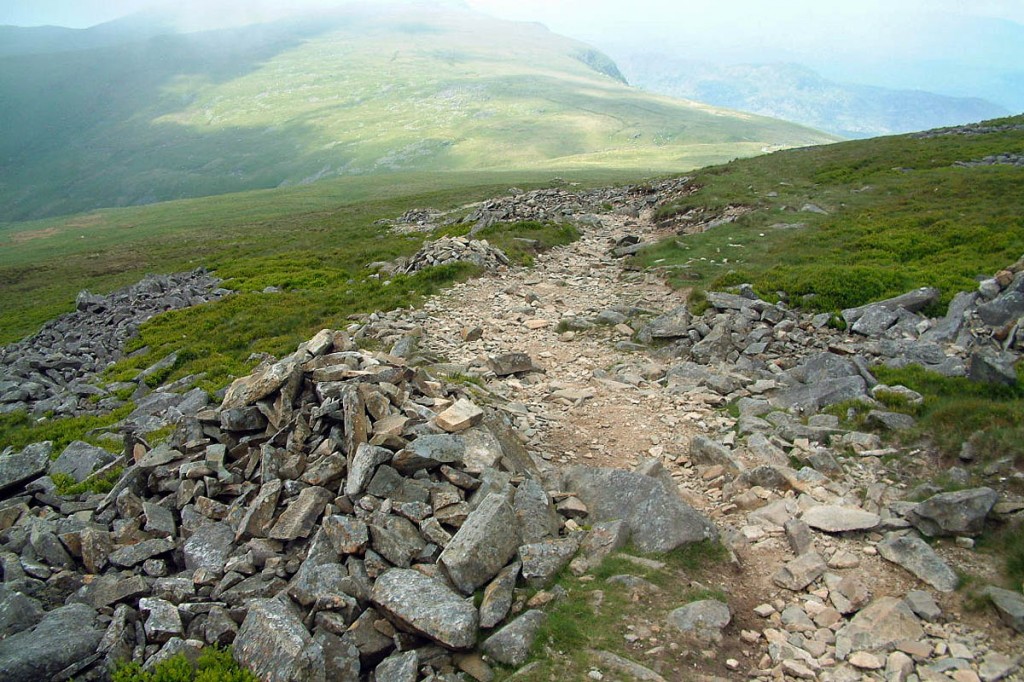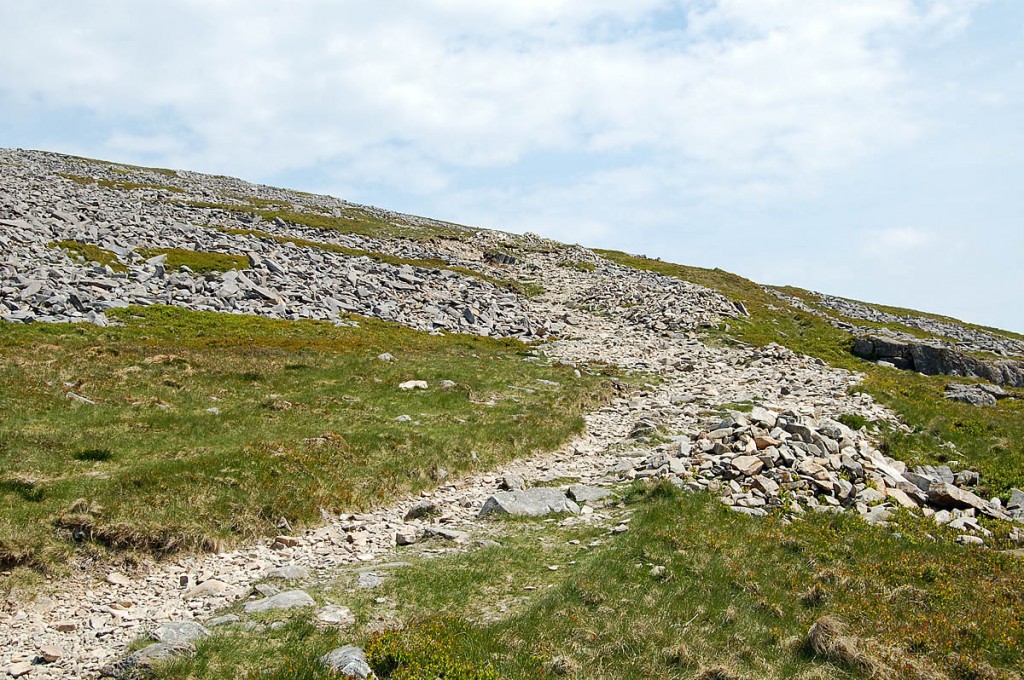National park wardens are pleading with walkers to stop making cairns on the mountains.
Snowdonia staff say footpaths and the fragile upland environment are being damaged by the custom of picking up stones and piling them up to mark routes.
And mountaineering’s official body backed the call to halt the building of these piles, saying it encouraged laziness in people as they no longer felt the need to follow a map.
The problem has become so severe that a demolition day is planned for cairns on the 893m (2,930ft) Cadair Idris in the South of the Snowdonia national park. Work has already begun to ‘rationalise’ some of the piles of stones in the northern part of the park.
Snowdonia National Park Authority said, over the years it has been the custom to build cairns on mountains to identify paths and junctions or dangerous places. But recently it has become common for walkers to identify the routes they have taken by placing a stone on a pile of stones to create a cairn.
Simon Roberts of the authority said: “It’s quite a problem on Cadair Idris.
“As the cairns are built, stone by stone, the footpaths are eroding and the fragile landscape is being damaged. Footpaths widen and the cost of maintaining the footpaths increase. But, even more dangerous, they can mislead walkers, especially in fog.
“Later this year, we will begin to rationalise the cairns, but in the meantime we are appealing to walkers to stop moving the stones on the mountains.”
Elfyn Jones, the British Mountaineering Council’s access and conservation officer for Wales, said: “Building cairns along the main paths on a popular mountain such as Cadair Idris is unnecessary and causes erosion of mountain habitats.
“It can also encourage laziness in people by not using a map and compass which can in turn lead them to a dangerous situation.”
Snowdonia warden Myfyr Tomos said: “On the Tŷ Nant footpath, within less than a mile between Rhiw Gwredydd and Bwlch y Cyfrwy, there are 102 cairns, and at the base of each cairn a very large hole where stones have been lifted from the path and adjacent land.
“Some of the stones are huge and the cairns are increasing every week. We need to ensure that future generations can enjoy walking the paths and mountains of Snowdonia and therefore reducing erosion by encouraging people not to move the stones, is a way of contributing to this.”
During the summer months, wardens in south Snowdonia will begin to tackle cairns on Cadair Idris. With the help of volunteers from the Welsh mountaineering club, Clwb Mynydda Cymru, the cairns will be reduced and some will be completely demolished.
Paul Williams, manager of the Cadair Idris nature reserve on behalf of Natural Resources Wales, said: “‘Building’ cairns has been of great concern over a number of years.
“The practice, by now, is totally unreasonable, creating scars on some of our most significant landscapes.
“The practice damages fragile habitats such as the moorland in the uplands and the scree, together with the animals and the plants associated with them. The damage can also cause new footpaths which expands erosion on our mountains.
“There are plenty of examples of this on the slopes of the Glyderau, Cadair Idris and Snowdon. A cairn should only show the summit of a mountain – where historical cairns are already there.”
Anyone interested in volunteering for the event can contact Simon Roberts at the national park office in Penrhyndeudraeth on 01766 770274.


Peter
03 February 2016An excellent plan to clear some of the mess these cairns make.
But all those cairns seem to have caused Cadair Idris to grow recently - it is shown as 893 metres high on my OS map.
Bob
03 February 2016Whoops! We could plead clumsy fingers or we could just plead guilty to not checking information given to us. Either way, we've now restored Cadair Idris to its true height. Sorry!
And thanks Peter for pointing out our error.
Mike
04 February 2016For years I've been dismantling/reversing the building of cairns wherever I think they are getting excessive. Why must humans feel the need to put rocks on top of other rocks wherever they go?!
Tripehound
04 February 2016I think cairns are a great idea. Why not paint them all orange so they are visible in poor conditions
Rant
04 February 2016Great idea I like it! How about adding some flashing lights as well?
H.
05 February 2016My twopence worth........ Having walked Cadair lots and lots for many many years.... the images of the Cairns you show above are mostly there as a result of the bags of rocks that were helicoptered in a few years back, they werent all distributed evenly but sometimes left in piles...........?!?!?
The erosion of the tracks this winter has been mostly due to the incredible rainfall we've had, perhaps if those rocks were distributed on the paths it may save some of them but the soil would still have washed away.
A T
05 February 2016Given that a much as we like the mountains, they are as unnatural and man made as can be (they should be covered in trees!) it's hard to see how cairns really make much of an impact in the bigger picture.
mr R Taylor
06 February 2016Yet again l think you should look into the history if cairns or the welsh carn , some of which are ancient and have been used ad waymarks by our ancestors. Although l would say that the building of new ones should not be aloud, destroying your old ones not only will you be knocking down ancient monuments but also endangering walkers who use them as marks ( on maps too ) in times when the weather closes in .also if This means walking off the path line then there will be less erosion. My honest opinion is that yet again modern people have forgotten what they are for and those in high office don't know there back end from there elbow . R
J breen
06 February 2016I do like the flashing lights idea
Stigofthenest
07 February 2016Thing is on hills like say the Tarrens there are very few cairns. Those that are there are in the most part antiquities. 5 miles up the road on Cad Idris and they are everywhere. This suggests a few things to me.
The Tarrens are more unspoilt by the hand of man.
That Cadair Idris is generally quite rocky.
People have a tendency to stick to paths even when they have unrestricted access, These same folks have a tendency to walk the more popular hills.
The issue of erosion is surely never going to be as serious on the slopes of Penygadair as say on the climb up to Moel Sych from llyn lluncaws in the Berwyns so I think its a bit of a fuss over nothing. Those who need cairns tend to be on the heavily cairned routes. Those who visit the quieter corners tend to know where theyre going anyway.
Not sure there would have been trees on the chair of Idris in the past though.